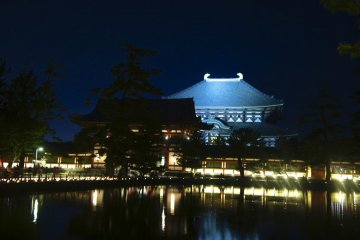
การประดับไฟที่วัดโทไดจิ นารา
Manish Prabhuneเทศกาลประจำปีโทคาเอะ ที่นารา เปิดโอกาสให้คุณได้ชมวัดโทไดจิในเวลากลางคืน ที่สว่างไสวสวยงาม ซึ่งมี ไม่บ่อยนัก

Todai-ji Temple, also known as the Great Eastern Temple, was originally built in 752 at the behest of Emperor Shomu. It is one of the most famous and historically significant temples in all of Japan and one of the landmarks of Nara. The Todai-ji Temple is a UNESCO World Heritage Site.
Until recently, the main hall of Todai-ji, Daibutsuden, was the largest wooden building in the world. The massive structure houses one of the largest cast bronze Buddha statues (Daibutsu) in Japan, which is 15 meters tall.
Another popular attraction is a pillar with a floor-level hole that is exactly the size of the Buddha's nostril. Whoever manages to squeeze through this opening will supposedly reach enlightenment in the next life.

เทศกาลประจำปีโทคาเอะ ที่นารา เปิดโอกาสให้คุณได้ชมวัดโทไดจิในเวลากลางคืน ที่สว่างไสวสวยงาม ซึ่งมี ไม่บ่อยนัก


วัดโทะไดจิ (Todaiji) นอกจากจะมีหลวงพ่อโตแล้ว ที่วัดยังมีรูปปั้นหลากหลายที่สวยงดงาม

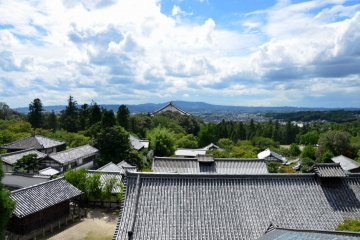
อาคารนิงะซึต-โดะ (Nigatsu-do) หรือ อาคารแห่งเดือนที่สอง (Hall of the Second Month) ซึ่งได้รับการยกย่องให้เป็นมรดกแห่งชาติ ตั้งอยู่ภายในบริเวณเขตวัดโทะไดจิ (Todai-ji) วัดที่มีชื่อเสียงโด่งดังแห่งเมืองนารา แม้ว่าจะมีผู้คนมากมายเข้าชมอาคารหลวงพ่อโตของวัดโทะไดจิ แต่ก็มีส่วนน้อยที่จะเดินลึกเข้าไปชมส่วนอื่นๆ ของพื้นที่ศักดิ์สิทธิ์แห่งนี้

ทางตะวันออกของศาลาพระพุทธเจ้าหลวงนั้น คือที่ตั้งของนิงัตสุ-โดะ ซึ่งเป็นศาลาที่มีความสวยงามและอยู่เหนือตัวเมืองนาราพร้อมกับวิวที่มองเห็นอาคารและทิวทัศน์ของนครเก่าแก่

ไคดันเป็นส่วนหนึ่งของวัดโทไดครั้งหนึ่งในอดีตเคยเป็นสถานที่ที่ศักดิ์สิทธิ์มากที่พระสงฆ์ผู้เข้ามาฝึกอบรมได้เริ่มเข้าสู่พุทธศาสนาโดยฝึกต่อหน้าพระอาจารย์
![วัดโทไดจิ [Todaiji Temple] วัดโทไดจิ [Todaiji Temple]](https://a1.cdn.japantravel.com/photo/9399-224954/360x240!/nara-วัดโทไดจิ-todaiji-temple-224954.jpg)
วัดโทไดจิ วัดที่มีความเก่าแก่และมีความสำคัญมากที่สุดวัดหนึ่ง ในเมืองนาระ

ผมไม่เคยนึกมาก่อนว่าจะมีบ้านพักแบบนี้อยู่ในนาราที่ญี่ปุ่นด้วย
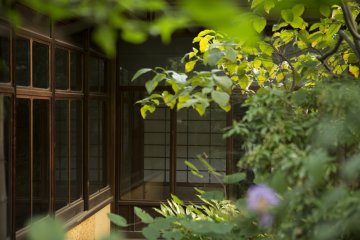
หลายคนคงสั่นหัวด้วยความสยดสยอง เมื่อใครกล่าวถึงคำว่า โฮสเทล (hostel) แต่ที่ญี่ปุ่นที่พักประเภทนี้ ให้ความหมายใหม่หมด ขออนุญาตให้ผมสร้างฉากหน่อยครับ

โรงแรมหรูใจกลางนาราพาร์ค ตั้งอยู่ใกล้กับวัดโคะฟุกุจิ และทะเลสาบอะระอิเกะ
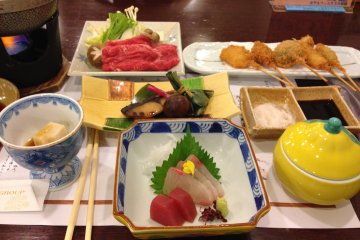
นารามีประวัติศาสตร์อันยาวนาน และอุดมไปด้วยอาหารอร่อยๆ หลากหลายชนิด และส่วนใหญ่จะมีเฉพาะในท้องถิ่นเท่านั้น

ร้านมิซุทะนิ-ชะยะ (Mizutani-chaya) ร้านอาหารเล็กๆ ที่ภายในมีโต๊ะอยู่เพียงสองสามตัว และม้านั่งด้านนอกให้นั่งชมวิวสวยๆ คำว่า "ชะยะ" (chaya) แปลได้คร่าวๆ ว่า ศาลาพักสำหรับคนเดินทาง
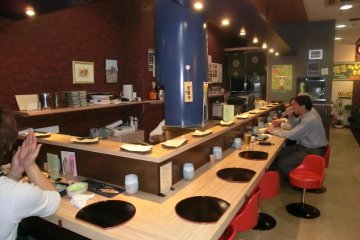
ผักหรือปลาเสียบไม้ชุบแป้งทอดสุดอร่อยจิ้มกับน้ำจิ้มหลายชนิด

The great Kasuga Shrine (Kasuga Taisha) is located in Nara Park. It was built at the same time as the capital and is dedicated to the deity responsible for protecting the city. The shrine was recognized as a UNESCO World Heritage Site in 1998. The most distinctive feature of the shrine is its 3,000 lanterns. Both stone lanterns and bronze lanterns were donated by believers and decorate the interior of the shrine. All 3,000 lanterns are lit twice a year. The first celebration in February (Setsubun Mantoro) represents the beginning of spring. The second celebration in August (Chugen Mantoro) honors the gentle transition into autumn. The shrine is also home to the Kasuga Taisha Museum, which houses some of the relics. This includes two sets of large, ornate drums.

NARA Visitor Center & Inn is located by the Sarusawa Pond in Nara City, a short walking distance from Kintetsu Nara station and Nara station. It is the hub for all travel resources when visiting Nara. If you have any questions, need travel recommendations, or are looking for transportation guidance this is the stop to make. The visitor center offers services that will ease your travels in Nara. Find an ATM serving overseas cards and foreign currency exchange at the service counter. Drop your bags off at the baggage storage to rid the excessive weight off your shoulders as you explore the nearby areas. The travelers lounge is equipped with computers and i-pads available for use free of charge. If they are taken, use the free Wi-Fi, to start planning your adventure on your own devices. Find pamphlets and maps for basic information and tips on where to go. The multilingual staff are also extremely helpful and are happy to share the must-see sights and eats that you will not find in travel pamphlets. In addition to the many services offered here, you will find daily walking tours and free cultural activities to participate in. This is a great chance to learn and experience the art of Ikebana (flower arranging), dress in a Tempyo gown, or challenge yourself with Japanese calligraphy. Take the free excursion buses available every Tuesday, Thursday, Saturday and Sunday until October 31st, for a ride to either Asuka Village or Mount Yoshino. The famous sights and activities are not limited to Nara City so don't miss out on this opportunity to explore all the beauty Nara Prefecture has to offer!

Toshodaiji Temple, located just north of Yakushiji Temple in Nara, is a significant site related to the development of Buddhism in Japan and signifies a connection between Japanese and Chinese cultures. The prestigious temple was founded in 759 by the Chinese monk Ganjin, who traveled to Japan in 754 after being asked by the emperor to help train monks and improve Japanese Buddhism. After retiring, Ganjin was granted land and consequently, established Toshodaiji to continue teaching Chinese Buddhist principles. Today, the temple is recognized as a UNESCO World Heritage Site. Without a doubt, Toshodaiji’s most impressive structure is its Kondo, or Main Hall, which was reopened to visitors in 2009 after nearly ten years of reconstruction work. The one-story Kondo, situated directly behind the Nandai-mon (Southern Great Gate), is the epitome of early Japanese-Buddhist architecture with a tiled sloping roof, seven bays, columns, and dark wood tones. Due to the building’s columned facade, it is often compared to the Parthenon. Inside, the hall houses principal Buddhist statues, which are designated as National Treasures. Standing before the hall, you cannot help but be swept away by its commanding presence. Near the Kondo is the Kodo Lecture Hall. This structure was originally built as an administrative building for the Nara Imperial Palace, but later relocated to Toshodaiji after it was gifted to Ganjin. Today, the hall is the only surviving building of the palace, and thus, a historically significant and rare part of the temple. Another prominent temple building is the Miei-do, which enshrines a famous wooden sculpture of Ganjin that his disciples created using hollow-core, dry-lacquer techniques. The exclusive building is only open to the public for a few days a year around June 6th. For all other days, visitors can view a replica of the statue, which was made on the 1,250th anniversary of Ganjin’s death, on display at the nearby Kaizando. In the eastern woods of the precinct lies Ganjin’s grave, one of the most tranquil areas of the temple. Follow a nature-laden path through thick foliage and then cross over a small bridge into the peaceful haven. Toshodaiji is also home to monk sleeping quarters, storehouses for sutras and treasures, and the Koro (Shariden), which is the site of the Uchiwamaki Ceremony, or Fan Scattering Festival, on May 19. Be sure to visit this remarkable temple and walk the footsteps of one of the most influential Chinese monks of Japanese Buddhism.